Stan Winston: Create Features
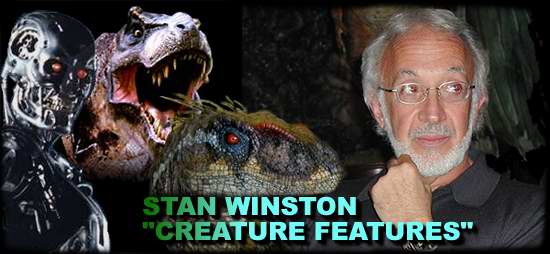
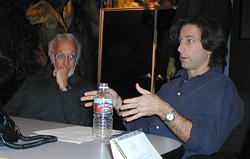
Stan Winston and John Rosengrant talk about ?their creations
Nestled in an unsuspecting warehouse just outside Hollywood, Stan Winston Studios is basically a huge workshop in which some of the world’s most talented artists, sculptors and animatronic engineers put together illusions that baffle and fool the eye.
“I am in awe every time I walk into this room, just as you are now,” an energetic Stan Winston says when meeting me and a number of other journalists in the company’s conference room, which is filled with life-size creature exhibits from the movies he worked on. From one corner a T-Rex is staring at visitors, while the Terminator lets you look down the barrel of his gun. A beautiful Raptor is eyeing you as you take a seat and a gorgeous “Small Soldiers” diorama reminds us of some truly great movie highlights. But that’s not all, above it all tower creatures and monsters, filling up every available inch of the room, all of them so realistic-looking that it can in fact become frightening.
Stan Winston and his special effects supervisor John Rosengrant spend all afternoon telling fascinating stories about the movies they made, pulling out staggering anecdotes about the Jurassic Park films. Winston is quick to admit that by the beginning of the projects, oftentimes, he has no idea how to achieve the effects he’s asked to do, but with his talented and highly skilled crew of engineers, artists and craftsmen, the studio always manages to pull of results that are beyond
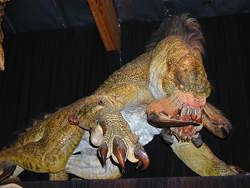
From “The Relic,” only one of the many creatures on display at Stan Winston Studios
Stan Winston is all about performances, which somehow sets him apart from many other special effects people. He views all his creatures as actors and not so much as props. “If you give an actor something to re-act to, you will get a performance. Let a great actor play off another great actor and you get great performances,” he says. “That’s also the reason why fully computer generated actors will never become a reality. We want to see Al Pacino act, not some animation!” With that in mind, he always tries to give his creatures the ability and flexibility to act and react on the set depending on what a scene needs to make sure the other actors who are also in the scene have something to work with. Does that mean he dislikes computer-generated images? Quite the opposite, actually. Early on he embraced the technology—in fact Stan Winston is one of the co-founders of “Digital Domain”—and uses it to extend the possibilities and abilities of his own creatures. “We can now use rod-puppets and have the rods all over the place without worrying about them. We simply remove them in the computer later.” That of course gives the puppeteers a larger degree of freedom, which helps to create more realistic performances.
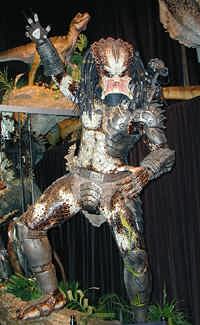
The Predator on his best behavior
In “Jurassic Park,” the team basically tried to create a life-size T-Rex that moves realistically without the robotic feel of a theme park attraction. It was one of the key achievements in the film, together with the seamless mix of Raptor models and computer generated ones. In the second film, the challenge was to create models that were more mobile. The result are rampaging T-Rexes and Raptors that are more agile. In the third film one of the challenges was to create an underwater attack of the Spinosaurus among others. With every film, the team tried to give the models a bigger range of capabilities that would allow for better performances.
About 50% of the dinosaurs in “Jurassic Park 3” are computer generated while the rest are hand- or radio-controlled Stan Winston creatures. Computer animation is mostly applied only in moments when the practical models can’t be used, or to enhance the performance. By no means does Winston see either approach as the end-all-be-all-solution, and makes sure they complement each other to create the best results possible.
Following the extensive conversation with Stan Winston and John Rosengrant, the two allowed us a close-up look behind the scenes, taking us into the workshops, where a “life” Raptor was already waiting. If you saw the movies, you think they are cool, but if you have seen one of these creatures perform in real life, you will be awestruck. At first sight, the Raptor looked and behaved like a life animal. There, I said it. The mannerisms, the way it cocked its head, the way the eye is fixating on you and blinks quickly, the way the neck is bending, is simply breathtaking, and when I touched the skin of the animatronic model, I almost expected it to be warm. No wonder they are utterly convincing on film, and Stan Winston goes even further, pointing out that hey can actually scare.
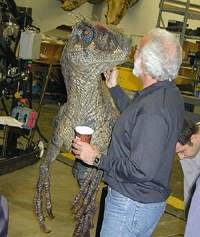
Welcome to the Stan Winston Petting Zoo
But it’s not only the big special effects that make up Stan Winston’s body of work and he’s most proud the work his studio did on “Instinct.” “Are you aware that there is not a single frame of real gorilla in that movie?” he asks? That’s right. All the gorillas in the film are animatronic Stan Winston creatures. While viewing a reel of effects the studio did, Winston points out a shot from “Interview With The Vampire” and says, “That’s a robot.”
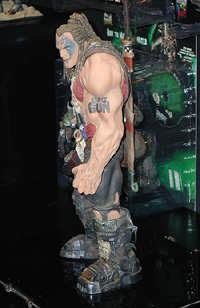
One of the action figures, forthcoming from Stan Winston Studios
Stan Winston Studios is also expanding in other territories now and many fans will be pleased to hear that the studio is currently preparing the launch of Stan Winston action figures. Beautifully crafted action figures that are original and tremendously detailed. Each one is designed from scratch and part of one of three lines that the studio is releasing. Wait until you see these and you will forget your McFarlane toys.
The dedication and enthusiasm that Stan Winston exubrates is infectious, certainly helping to make this studio such a unique place. Winston himself doesn’t really take credit—“I’m not doing anything,” he says with a laugh—when he guides and directs a group of incredibly talented people, and I tend to agree when he says that the people working in the movies these days are the Michelangelo’s of the 20th and 21st century. “In the past, the best artists were working for the church, painting cathedral ceilings or sculpting busts. Today they work in movies!” he exclaims, and I tend to agree. If you take a look at one of these models he has created you will quickly realize that each one of them is a unique piece of art. Priceless in its own way.




Leave a comment
You must be logged in to post a comment.